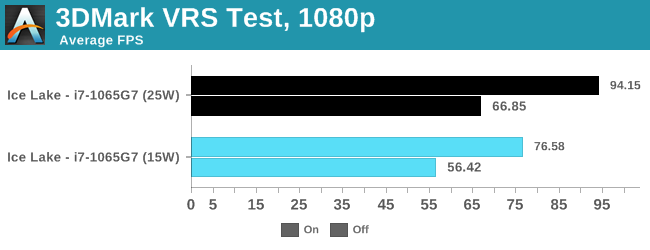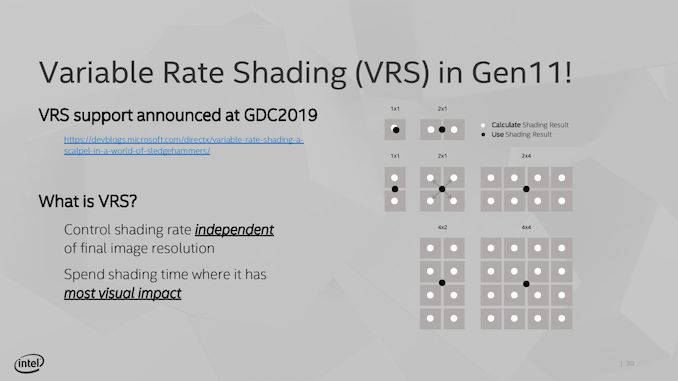The Ice Lake Benchmark Preview: Inside Intel's 10nm
by Dr. Ian Cutress on August 1, 2019 9:00 AM EST- Posted in
- CPUs
- Intel
- GPUs
- 10nm
- Core
- Ice Lake
- Cannon Lake
- Sunny Cove
- 10th Gen Core
Gaming Results (15W and 25W)
One of the biggest changes to the Ice Lake design is in the integrated graphics – Intel is now giving more focus and more die area to graphics, something it has arguably been neglecting for several years now. With Ice Lake, we move to a Gen11 graphics architecture, which is almost like the previous Gen9.5 but now with added support for variable rate shading (VRS), moving from 24 EUs to 64 EUs, and memory support up from LPDDR3-2133 to LPDDR4X-3733.


World of Tanks is a very CPU driven benchmark, and having the extra frequency of the 25W processor does help here. We're getting a sizeable uplift from Whiskey Lake, due to the extra EUs and memory frequency.


Our Final Fantasy test seemed to regress in 25W mode, although still within the noise. This test is still GPU bound, so adding the extra TDP to the CPU didn't actually help much. However, comparing to the Whiskey Lake integrated graphics, we've got over a 2x speedup.


Similarly with Civilization, with what is normally our 'IGP' settings, we are still GPU limited here.
One of Intel's newest features is Variable Rate Shading.
If developers add the option, soon to be an easy checkbox in Unity and Unreal, the game can decide to control the rate at which it shades pixels, from calculating every pixel down using one result across a 4x4 grid, to save compute power. Currently the only way to test this is with the 3DMark functional demo.

The new VRS test in 3DMark is designed as a feature test to show the potential uplift effect from enabling variable rate shading within a game. In both 15W and 25W modes, the data saw a good uplift, and we seemed to get more out of the 25W mode than the 15W mode.














261 Comments
View All Comments
HStewart - Thursday, August 1, 2019 - link
I actually think the Ice Lake with eGPU setup would be quite nice, even without it - I believe with performance numbers that Dell XPS 13 2in1 could possibly give my Dell XPS 15 2in1 a run for its money.Also I curious with Thunderbolt 3 on the CPU now if any performance - keep in mind this is basically future USB4
One thing I saw related to SigGraph 2019, is AVX512 enhancements for 3d graphics processing coming in 3d ( not gaming but professional content creation ) world that it as 2x performance improvement on older systems - not sure how much this applies to Ice Lake system and require Xe to make it function
https://software.intel.com/en-us/siggraph/2019-ove...
RSAUser - Friday, August 2, 2019 - link
Tossing your GPU into an enclosure to run via thunderbolt is not a good idea, you're going to be heavily limited due to the added latency. It's a solution you only do as you are constantly traveling and never use the desktop while your laptop can't even run basic games.Phynaz - Friday, August 2, 2019 - link
What added latency. It’s pciegglaw - Sunday, August 4, 2019 - link
There are several decent reviews of eGPU enclosures out fairly recently - my conclusion from all of them was how INCONVENIENT it would be considering the size of the enclosures, total cost of the setup, and not a single enclosure I've seen reviewed matches the regular desktop performance. I would not travel with the eGPU, and if I'm at home a small micro-ATX build or ITX build ends up less cluttered and using a smaller footprint than a laptop + eGPU at a fraction of the price with better performance.sing_electric - Thursday, August 1, 2019 - link
There's an issue with CPU names in the 1st table ("Intel 10nm Ice Lake-U Series CPUs"):All the chips are listed as "Core i7" before their suffixes. When reading the new name nomenclature, I was like "wait, Intel's using Core i7 for.... everything now?" Later tables don't have this problem, though.
Ian Cutress - Thursday, August 1, 2019 - link
Should be fixed :)sing_electric - Thursday, August 1, 2019 - link
Much easier to read! And good that Intel's not using... "brand inflation?"ShowsOn - Thursday, August 1, 2019 - link
The two different (?) shades of dark blue makes these charts very hard to understand. Accept the faster dark blue bars are the 9900K, but it is just visually confusing.Ryan Smith - Thursday, August 1, 2019 - link
You make a good point. We've changed the SPEC charts so that all products use distinct colors. Thanks!zodiacfml - Thursday, August 1, 2019 - link
yawn. 10nm for nothing except the better IGP. they could have at least made it at least 6 core at lower clock speeds but more performance than last gen. at the same TDP. in fairness, this 10nm die is probably larger than AMD's single Ryzen 3000 7nm die